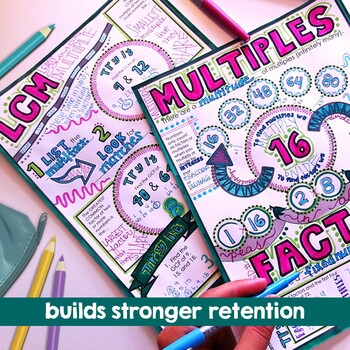Factors & Multiples Doodle Notes | Interactive Visual Math Doodle Notes
- PDF
What educators are saying
Description
Factors, Multiples, LCM, and GCF: 2 page visual "doodle notes" set- visual note taking pages with interactive tasks for building stronger retention of concepts with factors, multiples, least common multiple, and greatest common factor
Boost your students' focus and memory! The blend of graphic and linguistic input in these guided visual notes helps students' brains to convert the information to long-term memory more easily.
When students color or doodle in math class, it activates both hemispheres of the brain at the same time. There are proven benefits of this cross-lateral brain activity:
- new learning
- relaxation (less math anxiety)
- visual connections
- better memory & retention of the content!
Students fill in the sheets, answer the questions, and color, doodle or embellish. Then, they can use it as a study guide later on.
Content includes:
- difference between a factor and a multiple
- practice and examples
- analogies & visual memory triggers
- greatest common factor
- least common multiple
- practice and examples finding LCM and GCF with 2 or 3 numbers
Check out the preview for more detail about this item and the research behind it.
Visual note taking strategies like sketch notes or doodle notes are based on dual coding theory. When we can blend the text input with graphic/visual input, the student brain processes the information differently and can more easily convert the new learning into long-term memory.
This strategy also integrates the left and right hemispheres of the brain to increase focus, learning, and retention!
You might also like:





